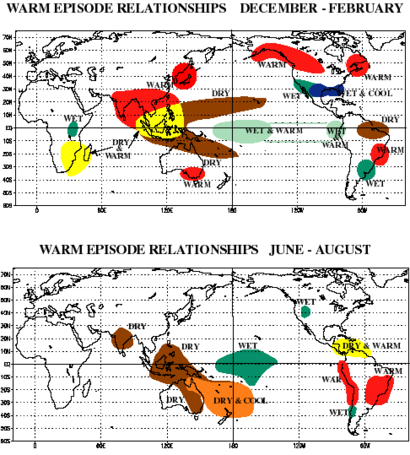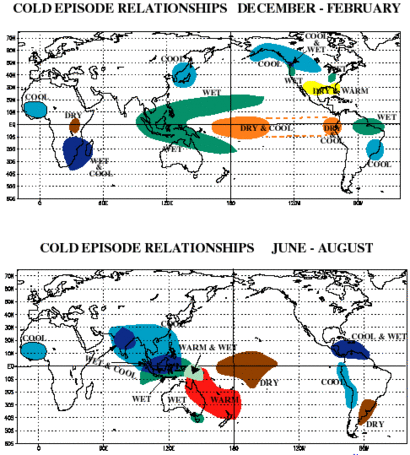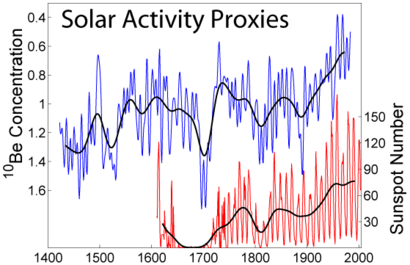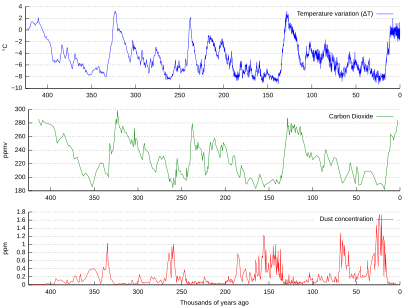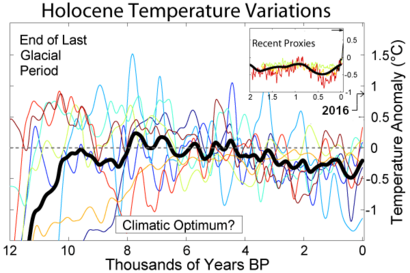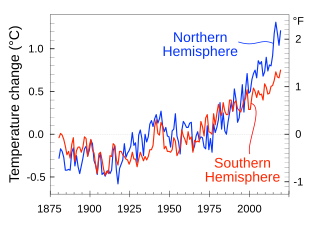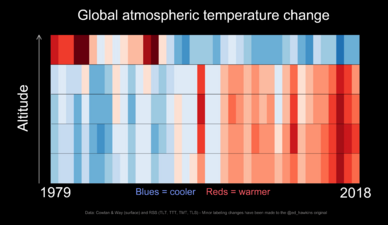Climate variability and change facts for kids
Climate variability means all the natural changes in Earth's climate that last longer than everyday weather events. The term climate change usually refers to bigger, longer-lasting changes, often over many decades or more. While "climate change" can describe any time in Earth's past, today it mostly means the changes happening right now. Since the Industrial Revolution, human activities have had a growing impact on our climate.
Earth's climate system gets almost all its energy from the sun. It also sends energy back out into outer space. The balance between the energy coming in and the energy going out is called Earth's energy budget. If more energy comes in than goes out, Earth warms up. If more energy goes out, Earth cools down.
The energy moving through Earth's climate system creates our weather. Weather changes in different places and at different times. The long-term averages and changes in weather for a region make up its climate. These climate changes can happen because of "internal variability." This means natural processes within the climate system change how energy is spread around. Examples include changes in ocean basins like the Pacific decadal oscillation and Atlantic multidecadal oscillation. Climate variability can also come from "external forcing." This is when events outside the climate system cause changes inside it. Examples include changes in the sun's energy or volcanism (volcano eruptions).
Climate variability can lead to changes in sea level, affect plant life, and even cause mass extinctions. It also has a big impact on human societies.
Contents
What Do These Words Mean?
Climate variability describes natural changes in the average state of the climate. It also includes changes in things like the chance of extreme weather. These changes happen "on all spatial and temporal scales beyond that of individual weather events." Some of these changes seem to happen randomly. This is called random variability or noise. Other changes happen more regularly, like cycles or patterns.
The term climate change is often used specifically for changes caused by humans. This is also known as global warming. Human activities cause anthropogenic climate change. This is different from natural climate changes that are part of Earth's normal processes.
So, "climate change" has become another way to say human-caused global warming. In science, global warming means the increase in surface temperatures. Climate change includes global warming plus all the other effects from rising greenhouse gas levels.
The World Meteorological Organization (WMO) first used "climatic change" in 1966. It covered all climate changes lasting longer than 10 years, no matter the cause. In the 1970s, "climate change" became the main term. This was because it became clear that human activities could greatly change the climate. The Intergovernmental Panel on Climate Change (IPCC) and the UN Framework Convention on Climate Change (UNFCCC) both use "climate change" in their names. Today, "climate change" describes both the process and the problem itself.
What Causes Climate Change?
The main things that shape climate are called climate forcings. These are like pushes or pulls on the climate system. They include changes in solar radiation (energy from the Sun), changes in Earth's orbit, and changes in how much light Earth reflects (called albedo). Other factors are mountain-building, continental drift, and changes in greenhouse gas amounts. External forcings can be from humans (like more greenhouse gases) or natural (like sun changes or volcanoes). There are also climate change feedbacks. These can make the initial change bigger or smaller. Sometimes, there are tipping points. If these are crossed, they can cause fast or irreversible changes.
Some parts of the climate system, like oceans and ice caps, react slowly to climate forcings. Others react quickly. For example, the atmosphere cools fast after a volcanic eruption. This happens because volcanic ash reflects sunlight. But ocean water warms slowly from thermal expansion, taking thousands of years. Sometimes, both happen. For instance, sea ice melts quickly in the Arctic Ocean, reducing albedo. Then, the water slowly expands as it warms.
Climate variability can also happen due to internal processes. These often involve changes in how energy is spread in the ocean and atmosphere. An example is changes in the thermohaline circulation (ocean currents).
Natural Changes Within Earth's System
Climate changes from internal variability sometimes happen in cycles. For other natural changes, we can't predict when they will happen. These are called random or stochastic changes. From a climate point of view, weather can be random. If there are few clouds in a year, extra heat can be absorbed by the oceans. Because of climate inertia, this heat can be "stored" in the ocean. It can then show up as variability over longer times than the original weather changes.
Ocean and Atmosphere Changes
The ocean and atmosphere can work together to create natural climate changes. These can last for years or even decades. These changes can affect the global average surface temperature. They do this by moving heat between the deep ocean and the atmosphere. They can also change how clouds, water vapor, and sea ice are spread. This affects Earth's total energy budget.
Cycles and Oscillations
A climate oscillation or climate cycle is a repeating pattern within global or regional climate. They are not perfectly regular. Many oscillations have been found or suggested:
- The El Niño–Southern Oscillation (ENSO): This is a big pattern of warmer (El Niño) and colder (La Niña) sea surface temperatures in the Pacific Ocean. It affects weather worldwide. It's the most important known source of year-to-year changes in global weather and climate. This cycle happens every two to seven years. El Niño lasts nine months to two years within the longer cycle.
- The Pacific decadal oscillation: This is the main pattern of sea surface changes in the North Pacific over decades. In a "warm" phase, the west Pacific gets cool and part of the eastern ocean warms. In a "cool" phase, the opposite happens.
- The Atlantic multidecadal oscillation: This is a pattern of change in the North Atlantic that lasts about 55 to 70 years. It affects rainfall, droughts, and how often and strong hurricanes are.
- The Arctic oscillation (AO) and Antarctic oscillation (AAO): These are natural, hemisphere-wide patterns of climate variability. They strongly influence the temperature and rainfall of land areas in the middle to high latitudes.
Ocean Current Changes
Ocean currents move a lot of energy from warm tropical areas to colder polar regions. Changes around the last ice age show that ocean circulation in the North Atlantic can change suddenly and a lot. This leads to global climate changes, even if the total energy coming into the climate system didn't change much. These big changes might have come from Heinrich events. This is when ice sheets became unstable and released huge icebergs into the ocean. When the ice melts, the water is very cold and has little salt. This drives changes in ocean circulation.
How Life Affects Climate
Life affects climate through its role in the carbon and water cycles. It also affects things like albedo (how much light is reflected), evapotranspiration (water moving from plants to air), cloud formation, and weathering (rocks breaking down). Here are some examples of how life might have affected past climate:
- About 2.3 billion years ago, glaciation was triggered by the evolution of oxygen-producing photosynthesis. This removed the greenhouse gas carbon dioxide from the atmosphere and added free oxygen.
- About 300 million years ago, another glaciation began. This was due to the long-term burial of plant remains that resist decay (creating a carbon sink and forming coal).
- The end of the Paleocene–Eocene Thermal Maximum 55 million years ago was helped by thriving marine phytoplankton.
External Forces on Climate
Greenhouse Gases
Greenhouse gases like CO2, methane, and nitrous oxide warm the climate system by trapping infrared light. Volcanoes also release carbon dioxide from Earth's crust and mantle over very long (geological) periods. This balances the carbon taken up by rocks.
Since the industrial revolution, humans have added to greenhouse gases. We do this by burning fossil fuels and changing land use through deforestation. We have also changed the climate with aerosols (tiny particles in the air) and other gases. Other factors like ozone depletion, animal farming (like cattle producing methane), and deforestation also play a role.
The US Geological Survey estimates that volcanic emissions are much lower than current human activities. Human activities generate 100–300 times more carbon dioxide than volcanoes. The amount humans release each year might be more than what supereruptions release. The most recent supereruption was the Toba eruption in Indonesia 74,000 years ago.
Earth's Orbit Changes
Small changes in Earth's motion cause changes in how sunlight reaches Earth's surface throughout the seasons. The total amount of sunshine averaged over the year doesn't change much. But its distribution across the globe and seasons can change a lot. The three types of changes are in Earth's eccentricity (how oval its orbit is), changes in the tilt of Earth's axis, and precession (the wobble of Earth's axis). Together, these create Milankovitch cycles. These cycles affect climate and are linked to ice ages and interglacial periods (warmer periods between ice ages).
During ice ages, there was a strong link between CO2 levels and temperatures. When ocean temperatures increase, CO2 becomes less soluble and is released from the ocean. These and other self-reinforcing processes allow small changes in Earth's motion to have a big effect on climate.
Sun's Energy Output
The Sun is the main source of energy for Earth's climate system. Other sources include heat from Earth's core and tidal energy from the Moon. Long-term changes in the sun's intensity are known to affect global climate. Solar output varies over shorter times too, like the 11-year solar cycle. The link between sunspots and climate is not very strong.
Three to four billion years ago, the Sun was only 75% as powerful as it is today. If Earth's atmosphere was the same as today, liquid water shouldn't have existed. But there is evidence of water on early Earth. This is known as the faint young Sun paradox. One idea to solve this is that the early atmosphere had much higher levels of greenhouse gases. Over the next 4 billion years, the Sun's energy output increased. In about five billion years, the Sun will become a red giant and then a white dwarf. This will have huge effects on Earth's climate.
Volcanoes
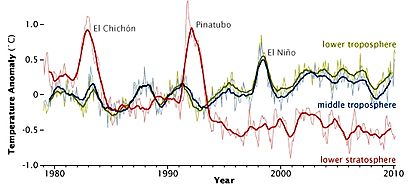
Eruptions big enough to affect Earth's climate for more than a year are those that inject over 100,000 tons of SO2 into the stratosphere. This is because SO2 and sulfate aerosols strongly absorb or scatter sunlight. They create a global layer of sulfuric acid haze. On average, such eruptions happen a few times each century. They cause cooling for several years by partly blocking sunlight from reaching Earth's surface.
Famous eruptions in history include the 1991 eruption of Mount Pinatubo. It lowered global temperatures by about 0.5 °C (0.9 °F) for up to three years. The 1815 eruption of Mount Tambora caused the Year Without a Summer.
Plate Tectonics
Over millions of years, the movement of tectonic plates changes the shape of continents and oceans. This also creates mountains and other landforms. These changes can affect global and local climate patterns and how oceans and the atmosphere circulate.
The position of continents affects the shape of oceans. This influences ocean currents. The locations of seas are important for moving heat and moisture around the globe. This, in turn, shapes global climate. For example, the formation of the Isthmus of Panama about 5 million years ago stopped direct mixing between the Atlantic and Pacific Oceans. This greatly affected the Gulf Stream and might have led to ice cover in the Northern Hemisphere.
The size of continents also matters. Oceans help keep temperatures stable. So, yearly temperature changes are usually smaller near coasts than inland. A larger supercontinent will have more areas with strong seasonal climates than several smaller continents or islands.
How Do We Know About Climate Changes?
Paleoclimatology is the study of climate changes throughout Earth's history. Scientists use different methods to get data from things like rocks, sediments, ice sheets, tree rings, corals, and fossils. They use these records to figure out what Earth's climate and atmosphere were like in the past. Direct measurements give a more complete picture of recent climate changes.
Direct Measurements
Climate changes that happened after measuring devices became common can be seen directly. We have fairly complete global records of surface temperature starting from the mid-to-late 1800s. Other observations come indirectly from historical documents. Satellite data for clouds and rainfall has been available since the 1970s.
Historical climatology studies how climate has changed in the past and its effect on human history. Main sources include written records like sagas, chronicles, maps, and local history books. Pictures like paintings and drawings are also used. Climate changes in the recent past can be found from changes in how people settled and farmed. Archaeological evidence, oral history, and historical documents can give clues about past climate changes. Climate changes have been linked to the rise and fall of different civilizations.
Proxy Measurements
Rocks, trees, and fossils hold clues about past climates. From these, scientists can get indirect measures of climate, called proxies. We can estimate past rainfall using things like ocean sediments, ice cores, cave formations (stalagmites), and tree rings. If trees are stressed by too little rain or bad temperatures, their growth rate changes. Scientists can study tree rings to learn about past climate trends. This science is called dendroclimatology.
Ice cores drilled from ice sheets, like the Antarctic ice sheet, show a link between temperature and global sea level changes. Air trapped in bubbles in the ice can also show how CO2 levels in the atmosphere changed long ago. Studying these ice cores has been very important for understanding past CO2 changes.
Plant remains, especially pollen, are also used to study climate change. Different plants grow in different climate conditions. Different groups of plants have pollen with unique shapes. The outer surface of pollen is very strong, so it doesn't decay easily. Changes in the type of pollen found in different layers of sediment show changes in plant communities. These changes often mean the climate was changing.
What Are the Impacts of Climate Change?
On Life
Plants

Changes in climate can lead to changes in the type, spread, and amount of plants. Some climate changes might bring more rain and warmth. This can make plants grow better and take more CO2 from the air. A slow increase in warmth in a region will make plants flower and fruit earlier. This changes the timing of life cycles for other organisms that depend on them. On the other hand, cold will make plant cycles slower.
However, bigger, faster, or more extreme changes can stress plants. This can lead to quick plant loss and desertification in some cases. An example happened during the Carboniferous Rainforest Collapse (CRC) 300 million years ago. Huge rainforests covered the equator in Europe and America. Climate change destroyed these rainforests. It broke their habitat into isolated "islands," causing many plant and animal species to die out.
Animals
One important way animals deal with climate change is by moving to warmer or colder regions. Over longer times, evolution helps ecosystems and animals adapt to a new climate. But fast or big climate changes can cause mass extinctions. This happens when creatures can't adapt quickly enough.
Humans
The collapse of past civilizations, like the Maya, might be linked to cycles of rainfall, especially droughts. Around 70,000 years ago, the Toba supervolcano eruption caused a very cold period during the ice age. This might have led to a genetic bottleneck in human populations.
Changes in Ice and Sea Level
Glaciers and Ice Sheets
Glaciers are very sensitive to a changing climate. Their size depends on a balance between new snow and melting ice. As temperatures rise, glaciers shrink unless more snow falls to make up for the extra melt. Glaciers grow and shrink due to both natural changes and outside forces. Changes in temperature, rainfall, and water can greatly affect how a glacier changes in a certain season.
The most important climate processes since about 3 million years ago are the glacial and interglacial cycles. The current warm period (the Holocene) has lasted about 11,700 years. These cycles are shaped by orbital variations. Responses like the rise and fall of continental ice sheets and big sea-level changes helped create the climate. Other changes, like Heinrich events and the Younger Dryas, show how glacier changes can also affect climate without orbital forcing.
Sea Level Changes
During the Last Glacial Maximum, about 25,000 years ago, sea levels were about 130 meters lower than today. The melting of ice after that led to rapid sea level changes. In the early Pliocene, global temperatures were 1–2 °C warmer than today. Yet, sea level was 15–25 meters higher.
Sea Ice
Sea ice is very important for Earth's climate. It affects how much sunlight is reflected away from Earth. In the past, Earth's oceans have been almost completely covered by sea ice. This was during "Snowball Earth" states. They have also been completely ice-free during warm periods. When there is a lot of sea ice globally, especially near the tropics, the climate is more sensitive to forcings. This is because the ice–albedo feedback is very strong.
Earth's Climate History
Different climate forcings are always changing throughout geologic time. Some processes that affect Earth's temperature might be self-regulating. For example, during the Snowball Earth period, huge ice sheets reached Earth's equator. They covered almost the entire surface. The very high albedo (reflectivity) made temperatures extremely low. Snow and ice buildup likely removed carbon dioxide from the atmosphere. However, there were no plants to absorb atmospheric CO2 from volcanoes. This meant greenhouse gases could build up in the atmosphere. There were also no exposed silicate rocks, which use CO2 when they break down. This created warming that later melted the ice and brought Earth's temperature back up.
The Paleocene–Eocene Thermal Maximum
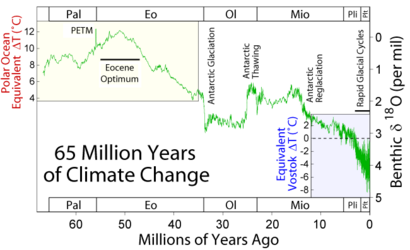
The Paleocene–Eocene Thermal Maximum (PETM) was a time when global average temperatures rose by more than 5–8 °C. This happened at the boundary of the Paleocene and Eocene geological epochs. During this event, large amounts of methane were released. Methane is a powerful greenhouse gas. The PETM is like a "case study" for modern climate change. This is because greenhouse gases were released relatively quickly in geological terms. During the PETM, many deep-ocean organisms died out.
The Cenozoic Era
Throughout the Cenozoic, many climate forcings caused the atmosphere to warm and cool. This led to the early formation of the Antarctic ice sheet, its later melting, and then its regrowth. The temperature changes happened somewhat suddenly. Carbon dioxide levels were about 600–760 ppm, and temperatures were about 4 °C warmer than today. During the Pleistocene, cycles of ice ages and warmer periods happened roughly every 100,000 years.
Climate temperatures greatly affect cloud cover and rainfall. At lower temperatures, air holds less water vapor. This can lead to less rainfall. During the Last Glacial Maximum 18,000 years ago, evaporation from the oceans onto land was low. This caused large areas of extreme desert, including cold polar deserts. In contrast, the world's climate was cloudier and wetter than today near the start of the warm Atlantic Period 8,000 years ago.
The Holocene Epoch
The Holocene is our current warm period. It has seen a long-term cooling trend after the Holocene climatic optimum. At that time, temperatures were probably just below current temperatures (early 21st century). A strong African Monsoon created grasslands in the Sahara during the Neolithic Subpluvial. Since then, several cooling events have happened, including:
- The Little Ice Age
- A cooling phase from about 1940–1970
In contrast, several warm periods have also taken place:
- The Roman Warm Period
- The Medieval Warm Period
- Modern warming during the 20th century
Some effects have happened during these cycles. For example, during the Medieval Warm Period, the American Midwest had droughts. The black death plague also happened during Medieval temperature changes and might be related to changing climates.
Solar activity might have contributed to some of the modern warming that peaked in the 1930s. However, solar cycles cannot explain the warming seen since the 1980s to today. Events like the opening of the Northwest Passage and recent record low ice in the Arctic shrinkage have not happened for at least several centuries. Early explorers could not cross the Arctic, even in summer. Shifts in biomes (major habitats) and animal ranges are also happening at rates that don't match known climate cycles.
Modern Climate Change and Global Warming
Because humans are releasing greenhouse gases, global surface temperatures have started to rise. Global warming is part of modern climate change. This term also includes changes in rainfall, storm paths, and cloudiness. As a result, glaciers worldwide are shrinking significantly. Land ice sheets in both Antarctica and Greenland have been losing mass since 2002. This loss has sped up since 2009. Global sea levels have been rising due to thermal expansion (water expanding as it warms) and melting ice. The decrease in Arctic sea ice, both in area and thickness, over the last few decades is more proof of rapid climate change.
How Climate Varies by Region
- Examples of regional climate variability
Besides global climate changes over time, many climate variations happen at the same time in different physical regions.
The oceans absorb about 90% of the extra heat. This has caused land surface temperatures to rise faster than sea surface temperatures. The Northern Hemisphere has more land compared to ocean than the Southern Hemisphere. So, it shows greater average temperature increases. Changes across different latitude bands also show this difference in average temperature increase. The temperature increase in the northern extratropics is more than in the tropics. And the tropics' increase is more than the southern extratropics.
Upper parts of the atmosphere have been cooling at the same time as the lower atmosphere warms. This confirms the action of the greenhouse effect and ozone depletion.
Observed regional climate variations confirm predictions about ongoing changes. For example, comparing smoother global year-to-year changes with more volatile year-to-year changes in local regions. Also, comparing different regions' warming patterns to their own historical changes helps put the temperature changes into perspective.
Regional variability observations allow us to study regional climate tipping points. These include rainforest loss, ice sheet and sea ice melt, and permafrost thawing. These differences help research into a possible global chain reaction of tipping points.
See also
 In Spanish: Cambio climático para niños
In Spanish: Cambio climático para niños
- Climatological normal
- Anthropocene
|


